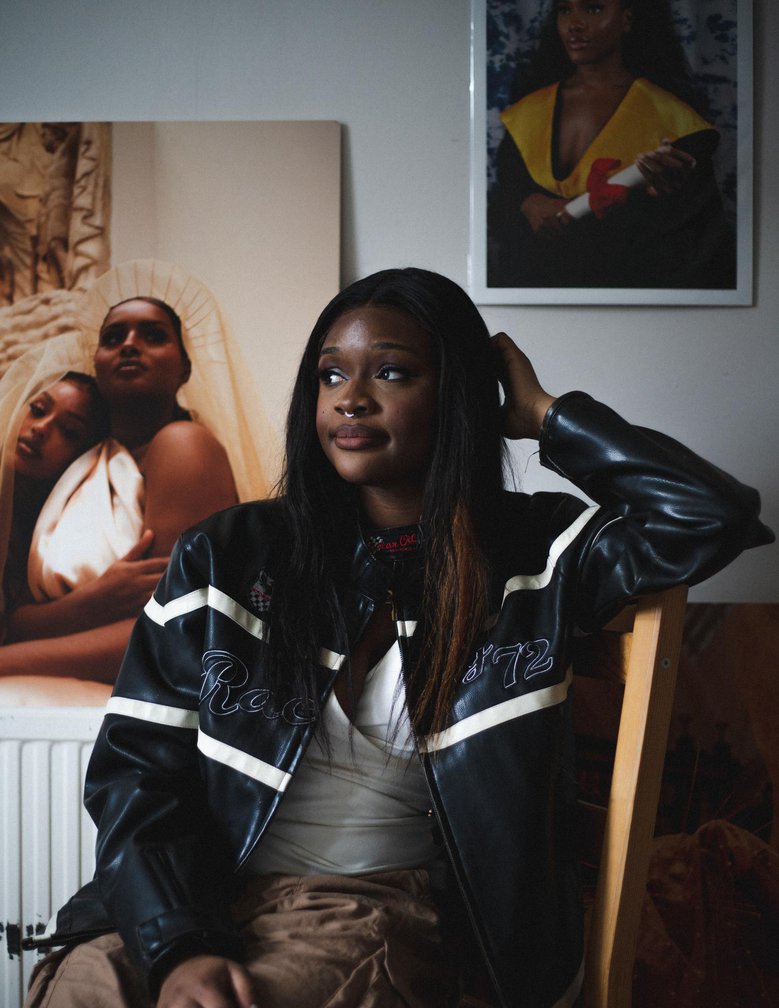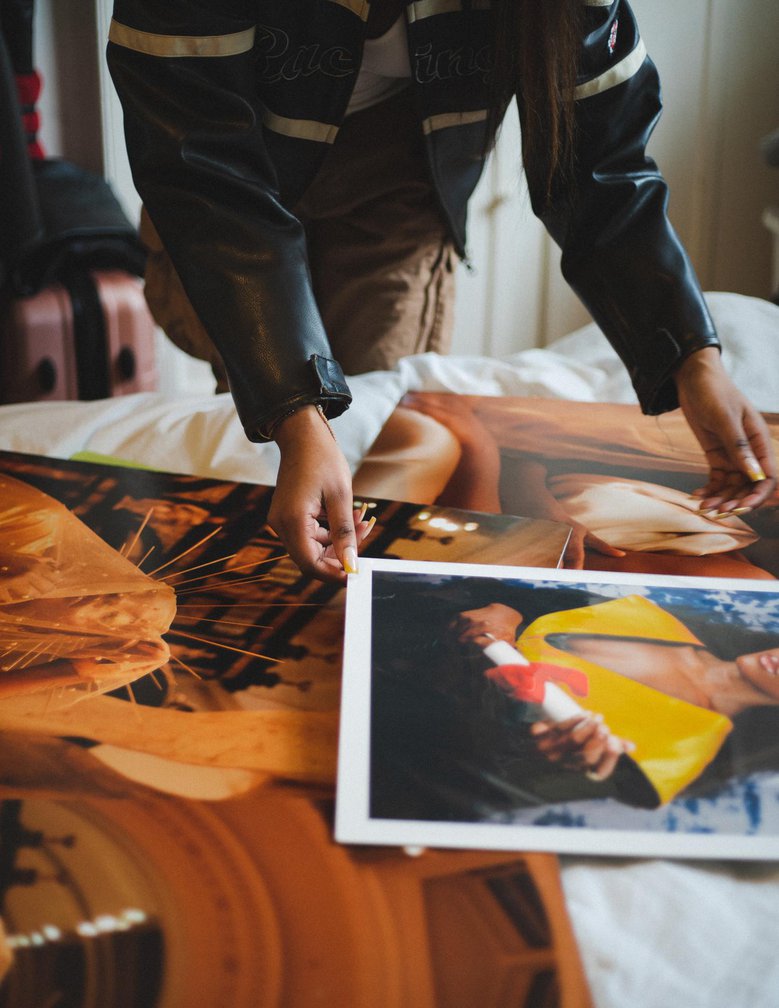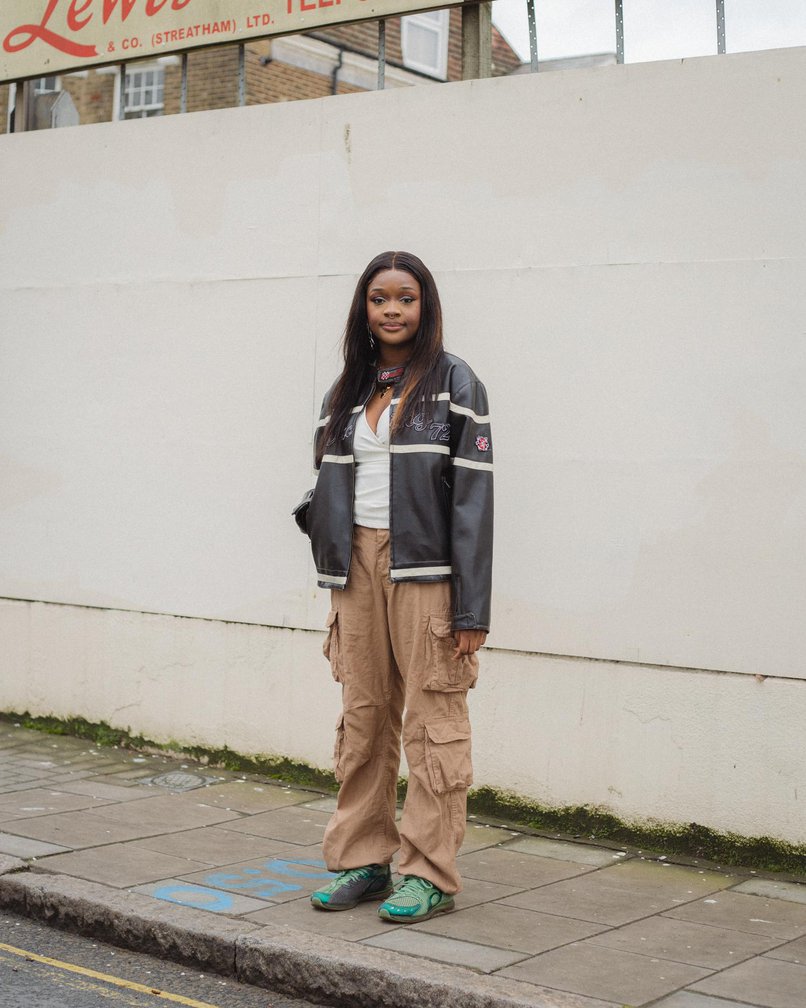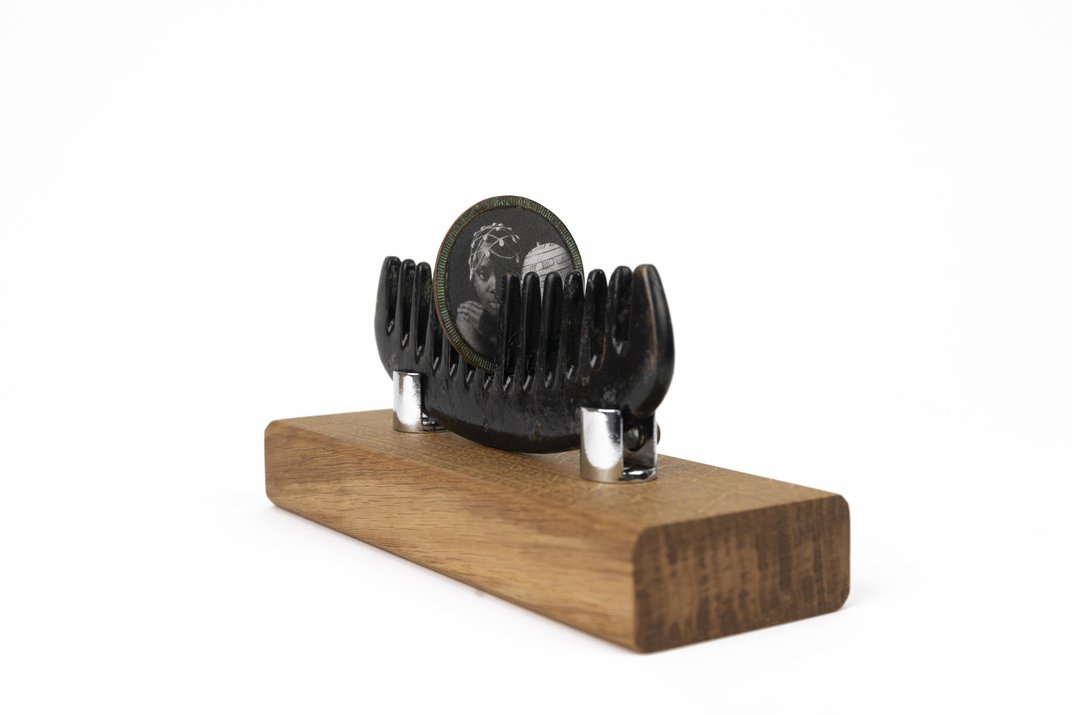article In conversation with
Aisha Seriki
In conversation with
Aisha Seriki
Aisha Seriki

In conversation with Aisha Seriki
about symbolism, finding sitters,
and the power of Toni Morrison.
about symbolism, finding sitters,
and the power of Toni Morrison.
In conversation with Aisha Seriki
about symbolism, finding sitters,
and the power of Toni Morrison.
Aisha Seriki is a Nigerian visual artist based in London. Aisha’s interest in photography stems from her father’s obsession with documentation, particularly of her significant childhood events. Her practice addresses blackness, gender, migration, class and the many points of intersection between all four. We recently caught up with Aisha to discuss the growth of her practice and her plans post-graduation.

Artiq What initially sparked your interest in photography? Why?
Aisha I became interested in photography through my father’s obsession with documenting my childhood. I was reignited with my love of photography whilst doing my art GSCE’S. At the time I was particularly interested in mixed media works, collages and the works of Barbara Kruger and Cindy Sherman. I was drawn to photography and used it as a method of documenting local communities and urban landscapes. I also loved photography; it allowed me to imagine new realities which was oppositional to my life experiences at the time.
Artiq You have showcased your work at various locations such as the Arc Salon in Stroud, Our Lives at 30 Fenchurch Street, and Becoming British at Bloc Projects. What do you hope that your audience experiences from engaging with your work?
Aisha I would like to create slow work that holds the attention of the audience that it is presented to. I hope to create work in which audiences can learn something new and pick up a new detail, every time they view it. I hope that it relates to different audiences and that they can each take something different from the same work. I hope my work reflects the extent to which history influences the present. For those unaware of the Yoruba cosmos, I hope that it brings up questions, and brings awareness about Yoruba Spirituality.
Aisha I became interested in photography through my father’s obsession with documenting my childhood. I was reignited with my love of photography whilst doing my art GSCE’S. At the time I was particularly interested in mixed media works, collages and the works of Barbara Kruger and Cindy Sherman. I was drawn to photography and used it as a method of documenting local communities and urban landscapes. I also loved photography; it allowed me to imagine new realities which was oppositional to my life experiences at the time.
Artiq You have showcased your work at various locations such as the Arc Salon in Stroud, Our Lives at 30 Fenchurch Street, and Becoming British at Bloc Projects. What do you hope that your audience experiences from engaging with your work?
Aisha I would like to create slow work that holds the attention of the audience that it is presented to. I hope to create work in which audiences can learn something new and pick up a new detail, every time they view it. I hope that it relates to different audiences and that they can each take something different from the same work. I hope my work reflects the extent to which history influences the present. For those unaware of the Yoruba cosmos, I hope that it brings up questions, and brings awareness about Yoruba Spirituality.

Artiq Who has been the most influential figure within your art practice? What have you learned from them?
Aisha I have had many inspirational figures spanning the length of my creative practice. The inspiration figures change frequently in response to my academic interests or my current life experiences. The majority of my heroes exist outside the space of Art, but I am inspired by the approaches they take in their work.
I am mainly inspired by the work of writers such as Saidaya Hartman and Octavia Butler. Toni Morrison is also a big inspiration for me, I love the symbolism in her work and how full-bodied and complex her characters are. As a reader, I find that her work is challenging and is certainly not the easiest to read, but it forces me to inspect her characters in closer detail. Inspired by this, I aim to create work which is multi-layered, so that the audience are forced to look at the finer detail.
In terms of artists who influence my practice visually, I like the works of filmmaker Isaac Julien, Surrealists from Photography and Painting, as well as Kara Walker and Claude Cahun. I like works that are grounded outside our current existence.
Aisha I have had many inspirational figures spanning the length of my creative practice. The inspiration figures change frequently in response to my academic interests or my current life experiences. The majority of my heroes exist outside the space of Art, but I am inspired by the approaches they take in their work.
I am mainly inspired by the work of writers such as Saidaya Hartman and Octavia Butler. Toni Morrison is also a big inspiration for me, I love the symbolism in her work and how full-bodied and complex her characters are. As a reader, I find that her work is challenging and is certainly not the easiest to read, but it forces me to inspect her characters in closer detail. Inspired by this, I aim to create work which is multi-layered, so that the audience are forced to look at the finer detail.
In terms of artists who influence my practice visually, I like the works of filmmaker Isaac Julien, Surrealists from Photography and Painting, as well as Kara Walker and Claude Cahun. I like works that are grounded outside our current existence.

Artiq Can you provide insight into the process of photographing people as part of your artistic practice? How do you make decisions about the people you collaborate with, and what approaches do you use to establish connections with them?
Aisha I have had different approaches to photographing people over the years. One way in which I find my models is through Instagram. Typically spend a few hours a month searching for models, which I keep in a saved folder.
However, for most of my photography projects, I have an essence that I search for when looking for people to shoot. I tend to shoot people I know for my photography projects. For Ori Inu, the sitter needed to be a friend, because the project was so personal, so I chose my friend Haddi as the model.
I am also interested in challenging the hierarchy between the sitter and the photographer. For me, it was important, for Haddi to be involved in the process, and I encouraged any feedback and ideas from her whilst shooting.
Artiq You also work with sculpture, for example within your project Ori Inu (2023). Can you discuss your experience when working in this medium? Do you have plans to work more with sculpture in the future?
Aisha Metal Sculpture is a recent addition to my practice. It came about through my exploration of symbolism as a method of communication in my photography project Ori Inu. The comb was an idea that instantly came to mind. At first, I was shooting still lifes of combs and then it occurred to me, that I could try to make a comb which would somehow be a frame for my photos.
From conception to making the combs, the whole process was around six weeks. By making the combs, I learned that I have different approaches to creating. I would say that my photography method is very controlled. In contrast, my approach to sculpture is less defined and structured, and I allow myself to be at the mercy of the material I am working with.
Initially, I wanted a polished bronze comb but then I learnt that it was unlikely when using the lost wax process. The process of Patination is also hard to control, and so throughout this process of making, I gave up this idea of dominance and instead embraced the material for what it was.
I would like to make more sculptures in the future, I am interested in looking at sculpture through the lens of photography. I am really interested in the photograph as an object and the human connections that are created through the keepsake.
Aisha I have had different approaches to photographing people over the years. One way in which I find my models is through Instagram. Typically spend a few hours a month searching for models, which I keep in a saved folder.
However, for most of my photography projects, I have an essence that I search for when looking for people to shoot. I tend to shoot people I know for my photography projects. For Ori Inu, the sitter needed to be a friend, because the project was so personal, so I chose my friend Haddi as the model.
I am also interested in challenging the hierarchy between the sitter and the photographer. For me, it was important, for Haddi to be involved in the process, and I encouraged any feedback and ideas from her whilst shooting.
Artiq You also work with sculpture, for example within your project Ori Inu (2023). Can you discuss your experience when working in this medium? Do you have plans to work more with sculpture in the future?
Aisha Metal Sculpture is a recent addition to my practice. It came about through my exploration of symbolism as a method of communication in my photography project Ori Inu. The comb was an idea that instantly came to mind. At first, I was shooting still lifes of combs and then it occurred to me, that I could try to make a comb which would somehow be a frame for my photos.
From conception to making the combs, the whole process was around six weeks. By making the combs, I learned that I have different approaches to creating. I would say that my photography method is very controlled. In contrast, my approach to sculpture is less defined and structured, and I allow myself to be at the mercy of the material I am working with.
Initially, I wanted a polished bronze comb but then I learnt that it was unlikely when using the lost wax process. The process of Patination is also hard to control, and so throughout this process of making, I gave up this idea of dominance and instead embraced the material for what it was.
I would like to make more sculptures in the future, I am interested in looking at sculpture through the lens of photography. I am really interested in the photograph as an object and the human connections that are created through the keepsake.

Aisha Seriki - Ori Uni
Artiq You recently graduated from the RCA- congratulations! What was the most valuable thing you learned during your MA? What challenges did you face?
Aisha The most valuable thing I learned was to trust in the process, as cringy as that sounds.
Before doing my master's, I would have an idea and then shoot. There was no further development once this shoot was done and the idea would be left there. One thing I learnt, was letting go of the pressure I put on myself of always making the best work. Great ideas take time to process, so now I try to get out of the cycle of procrastination and make work without thinking of the outcome, to see where it develops. Initially, when I was taking the still lifes of combs, it felt like I was wasting my film because I had no idea how I would link with the portraits I had shot, through shooting more ideas were generated which brought me onto my metal combs.
I think the main challenge I faced was not having feedback on the work I created by my peers. It was very isolating, there were a few tears shed, it made me unsure of my work at the time but luckily that has changed.
Artiq Do you have any exciting upcoming projects or exhibitions that you would like to share with us?
Aisha I am currently making new work for my first solo show next year which I am excited for! I am currently doing another master's at the RCA. This year I am focused on expanding my practice, and I am interested in art writing and exploring performance work and moving image.
I am also working on making an experimental short film as an extension of my photography project Ori Inu, which will hopefully be released in early 2025.
Aisha The most valuable thing I learned was to trust in the process, as cringy as that sounds.
Before doing my master's, I would have an idea and then shoot. There was no further development once this shoot was done and the idea would be left there. One thing I learnt, was letting go of the pressure I put on myself of always making the best work. Great ideas take time to process, so now I try to get out of the cycle of procrastination and make work without thinking of the outcome, to see where it develops. Initially, when I was taking the still lifes of combs, it felt like I was wasting my film because I had no idea how I would link with the portraits I had shot, through shooting more ideas were generated which brought me onto my metal combs.
I think the main challenge I faced was not having feedback on the work I created by my peers. It was very isolating, there were a few tears shed, it made me unsure of my work at the time but luckily that has changed.
Artiq Do you have any exciting upcoming projects or exhibitions that you would like to share with us?
Aisha I am currently making new work for my first solo show next year which I am excited for! I am currently doing another master's at the RCA. This year I am focused on expanding my practice, and I am interested in art writing and exploring performance work and moving image.
I am also working on making an experimental short film as an extension of my photography project Ori Inu, which will hopefully be released in early 2025.

Aisha Seriki - Ori Uni